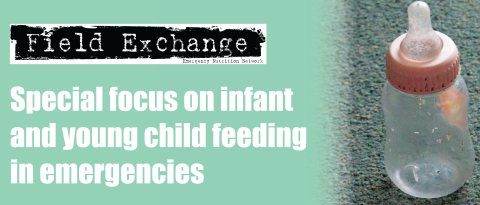RUTF use in adults in Kenya
Summary of meeting abstract1

A man enrolled in the RUTF acceptability programme

Those who were sicker found it more difficult to eat RUTF and tended to mix it with other foods

Heading home with supplies of RUTF
In 2007 in Nyanza Province in Kenya, Médecins Sans Frontières (MSF) enrolled HIV positive adults from a large Ministry of Health (MOH) /MSF HIV programme into a nutritional programme. The purpose of this was to study the acceptability of peanut-based Ready to Use Therapeutic Food (RUTF) to HIV+ adults and any issues that arise from its distribution and consumption.
A total of 56 patients and eight MoH/MSF staff were involved in the study. The patients were all taking antiretroviral therapy (ART), had a Body Mass Index (BMI) < 17 and/or Mid Upper Arm Circumference (MUAC) <185 and/ or oedema. They received four sachets of a peanut-based RUTF2 daily (energy equivalent 2,000 kcals/day). The research team used qualitative methods such as key informant interviews, focus groups and direct unobtrusive observations.
Results
The patients comprised 60% females, 85% were over 30 years of age and 32% were widowed. At the time of the study, 72% were receiving RUTF. Of these patients, 45% came to the clinic with a carer and 83% came on public transport (average journey time was two hours). The main physical barrier for adherence was distance to the HIV clinic. Due to the weight of the product and patient frailty, those without a carer could only take a two-week supply. Most of the patients only came back after a month (to coincide with their next appointment to collect the antiretroviral drugs) and so reduced the prescribed intake per day to make the available amount last. The patients were enthusiastic about their weight gain and the possibility of returning to daily activities. They reported, however, that they felt stigmatised for consuming RUTF, more so than for HIV drugs.
Half of the patients said they could not comply with the full prescription due to the taste of the product, dietary boredom and clinical conditions associated with HIV (oesophageal thrush, lack of appetite, nausea and vomiting). Sharing the RUTF ration with other household members was common, mainly due to poverty and household food insecurity. Patients were observed mixing RUTF with other foods, both to facilitate its consumption (in the case of thrush) and to break dietary boredom. This included mixing the RUTF with highly micronutrient-fortified porridges provided after discharge. Also, multimicronutrients tablets were commonly provided without advice on the correct amount and duration (contra-indicated in the MSF nutrition protocol). In those patients who did comply with the full prescription of RUTF, these practices posed a risk of exceeding the safe upper limits of micronutrient consumption. The medical staff did not receive training on the nutrition therapy and expressed a lack of understanding about the effectiveness of the treatment. They did not counsel the patients on why, when or how to take the RUTF. Staff also had difficulties in estimating height in the patients observed in this study, due to symptoms associated with severe malnutrition such as flexor contractions and scoliosis, which led to inaccuracies in BMI and RUTF doses.
Conclusions
This study suggests that an improved approach to treating malnourished HIV+ adults living in resource-poor settings is needed. This approach must take into consideration the differences that exist between the traditional outpatient programme designed for children and the challenging reality of malnourished adults, including the need for a novel RUTF specifically designed for malnourished adults with HIV.
1Dibari F, Le Galle, I Ouattara A , Bahwere P, Seal A (2008). A qualitative investigation of Plumpy'nut consumption in adults enrolled in an MoH/MSF programme in Kenya. Report on MSF Scientific Day. 'Research shaping the way we work'. 5th June 2008. http://www.msf.org.uk/scientificday.event
2Plumpy'nut, Nutriset, France.
Imported from FEX website


